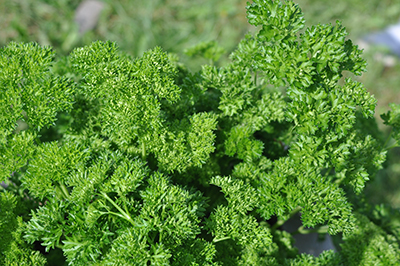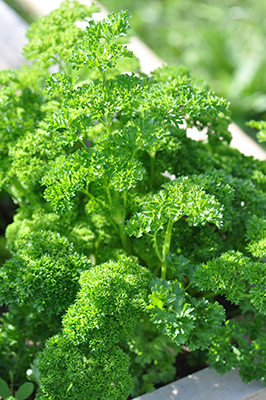Petroselinum sativum L. ssp. crispum (Apiaceae) cv. Mooskrause 2


| ENG | Leafy parsley |
| SK | Petržlen siaty |
| CZ | petržel setý |
| PL | Pietruszka naciowa |
| HU |
Using
Parsley is a widely used culinary, medicinal and aromatic plant. The fresh or dried leaves are used in the food, cosmetic and pharmaceutical industries to produce spice, essential oils, and drugs. Fresh leaves are used as a garnish and spice, while dry leaves ? as an ingredient to flavour soups and sausages. Leaves have carminative, diuretic, hypertensive, hypotensive, stomachic, emmenagogic, nervine, abortifacient, hypoglycemic, antidiabetic and nutritive action.
| I. | II. | III. | IV. | V. | VI. | VII. | VIII. | IX. | X. | XI. | XII. | |||||||||||||
| Sowing | ||||||||||||||||||||||||
| Harvest | ||||||||||||||||||||||||
Botanical description and occurrence:
Parsley ‘Mooskrause 2’ is a cultivar with curly leaves, dark green, delicate and very aromatic. Plants can well overwinter in the soil, develop new leaves early in spring. Leaves remain green under cover during winter and can be harvested as needed. Parsley is an excellent source of flavonoids (apiin, luteolin), apigenin glycosides, carotenoids, vitamin C, tocopherols, volatile compounds (myristicin, apiole), coumarines (bergapten, imperatorin), furanocoumarins, sesquiterpenes and phthalides.
Why to have the plant in your garden:
Excellent source of antioxidants. Leaves can be used fresh, dried, and freezed. Ideal as an aromatic spice.
Text:
Dr. Andrzej Kalisz, University of Agriculture in Krakow, Poland
Photo:
Dr. Ján Mezey, SUA, Nitra, Slovak Republic

